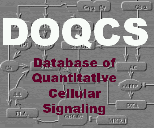
|
Enter a Search String | | Special character and space not allowed in the query term.
Search string should be at least 2 characters long. |
Molecule Parameter List for PKC-Ca-memb* | The statistics table lists the distribution of a molecule acting either as a substrate, product, enzyme or as a molecule within the network.
The text color of a molecule is highlighted by  color. color. | | Statistics |
Accession and Pathway Details | |
| Accession Name | Accession No. | Accession Type | Pathway Link | Synaptic_
Network | 16 | Network |
Shared_Object_Synaptic_Network, PKC, PLA2,
PLCbeta, Gq, MAPK,
Ras, EGFR, Sos,
PLC_g, CaMKII, CaM,
PP1, PP2B, PKA,
AC, CaRegulation | This model is an annotated version of the synaptic signaling network.
The primary reference is Bhalla US and Iyengar R. Science (1999) 283(5400):381-7 but several of the model pathways have been updated.
Bhalla US Biophys J. 2002 Aug;83(2):740-52
Bhalla US J Comput Neurosci. 2002 Jul-Aug;13(1):49-62 |
PKC-Ca-memb* acting as a Molecule in Synaptic_Network Network
| Name | Accession Name | Pathway Name | Initial Conc.
(uM) | Volume
(fL) | Buffered | | PKC-Ca-memb* | Synaptic_
Network
Accession No. : 16 | PKC
Pathway No. : 71 | 0 | 1000 | No | | This is the direct Ca-stimulated activity of PKC. |
PKC-Ca-memb* acting as a Summed Molecule in Synaptic_Network Network
| Accession Name | Pathway Name | Target | Input | Synaptic_
Network
Accession No. : 16 | Shared_Object_
Synaptic_
Network
Pathway No. : 70 | PKC-active | PKC-DAG-AA*
PKC-Ca-memb*
PKC-Ca-AA*
PKC-DAG-memb*
PKC-basal*
PKC-AA*
| | This is the total active PKC. It is the sum of the respective activities of PKC-basal* PKC-Ca-memb* PKC-DAG-memb* PKC-Ca-AA* PKC-DAG-AA* PKC-AA* I treat PKC here in a two-state manner: Either it is in an active state (any one of the above list) or it is inactive. No matter what combination of stimuli activate the PKC, I treat it as having the same activity. The scaling comes in through the relative amounts of PKC which bind to the respecive stimuli. The justification for this is the mode of action of PKC, which like most Ser/Thr kinases has a kinase domain normally bound to and blocked by a regulatory domain. I assume that all the activators simply free up the kinase domain. A more general model would incorporate a different enzyme activity for each combination of activating inputs, as well as for each substrate. The current model seems to be a decent and much simpler approximation for the available data. One caveat of this way of representing PKC is that the summation procedure assumes that PKC does not saturate with its substrates. If this assumption fails, then the contributing PKC complexes would experience changes in availability which would affect their balance. Given the relatively low percentage of PKC usually activated, and its high throughput as an enzyme, this is a safe assumption under physiological conditions. |
PKC-Ca-memb* acting as a Product in a reaction in Synaptic_Network Network
| Kd is calculated only for second order reactions, like nA+nB <->nC or nA<->nC+nD, where n is number and A,B,C,D are molecules, where as for first order reactions Keq is calculated.
Kd for higher order reaction are not consider. |
| Name | Accession Name | Pathway Name | Kf | Kb | Kd | tau | Reagents | | PKC-Ca-to-memb | Synaptic_
Network
Accession No. : 16 | PKC
Pathway No. : 71 | 1.2705
(s^-1) | 3.5026
(s^-1) | Keq = 2.7569(uM) | 0.21sec | Substrate
PKC-Ca
Product
PKC-Ca-memb*
| | Membrane translocation is a standard step in PKC activation. It also turns out to be necessary to replicate the curves from Schaechter and Benowitz 1993 J Neurosci 13(10):4361 and Shonomura et al 1991 PNAS 88:5149-5153. These rates are constrained by matching the curves in the above papers and by fixing a rather fast (sub-second) tau for PKC activation. |
| Database compilation and code copyright (C) 2022, Upinder S. Bhalla and NCBS/TIFR
This Copyright is applied to ensure that the contents of this database remain freely available. Please see FAQ for details. |
|
